Bethania (or Bethany) Welsh Baptist chapel is situated in William Street, Cardigan. It was built around 1775, and has received several alterations over the following years. Inside the chapel are two bronze memorial plaques, which commemorate the members of its congregation who fell during both World Wars. Many thanks to Mike Berrell for the photographs of the memorials.
The Great War, 1914-1918
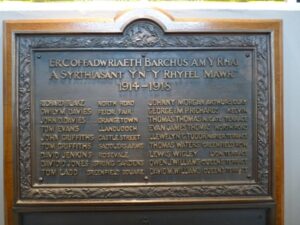
Richard Blake, Private, 48872, South Wales Borderers. Richard was born at Cardigan in 1898, the son of Benjamin and Mary Blake. The family later resided at 12, North Road, Cardigan. Richard enlisted at Brecon into the 6th Battalion, South Wales Borderers, which was the Pioneer Battalion to the 25th Division. The Division landed in France on 26 September 1915, and were posted to the Vimy area, where they defended Vimy Ridge against a German attack in May 1916. They then moved to the Warloy area and attacked on 3 July near Thiepval. They fought throughout the Battle of the Somme, and then moved to Ploegsteert, where they held the line for the months leading up the Battle of Messines in June 1917. After fighting at Messines, the Division moved north, and fought at Pilckem, before moving south again, where they took up positions around Bullecourt in reserve. Here the Division was used to reinforce the badly depleted British units that were hit in the area by the German Spring Offensive. They moved north to Flanders on the night of 30 March, where they took up positions at Ploegsteert again, where they received reinforcements, and rebuilt. However, on 9 April the Germans launched an offensive on the Lys, and the Division was caught up in the terrible fighting here. Richard was killed in action here on 10 April 1918. He was 19 years old, and is commemorated on the Ploegsteert Memorial, Belgium. His brother, David, also fell.
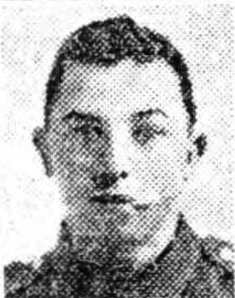
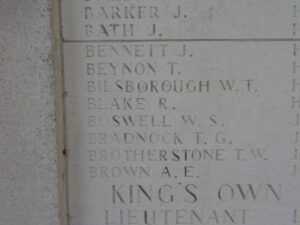
Gwilym Davies, Private, 35880, Welsh Regiment. Gwilym was the son of James and Ellen Davies, of 7, Feidrfair, Cardigan. He enlisted at Newport, Monmouth into the Welsh Regiment, and was posted to Salonika with the 11th Battalion (Cardiff), Welsh Regiment, which was attached to 67 Brigade, 22nd Division. Gwilym was taken ill with dysentery, and died in Salonika on 11 July 1916. He was 20 years old, and is buried at Mikra British Cemetery, Kalamaria, Salonika.
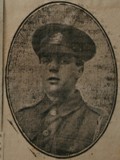
John Daniel Davies, Second Engineer, Mercantile Marine. John was born at Grangetown, Cardigan, the son of Daniel Davies. In August 1917 he married Mary Sarah Morris, and she set up the family home at Capel Llangeitho, Tregaron. John served in the Mercantile Marine as engineer aboard the SS Santa Amalia, a London registered cargo ship. On 28 December 1917, when 30 miles from Malin Head, Ireland she was torpedoed without warning and sunk by the German submarine U-19. John was among 43 men whose lives were lost that day. He was 28 years old, and is commemorated on the Tower Hill Memorial, London.
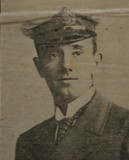
Thomas Evans, Seaman, 3646A, Royal Naval Reserve. Thomas was born at Cardigan on 22 May 1881, the son of Mary Evans. Prior to the war he resided with his wife, Elizabeth Evans, at 7, David Street, St. Dogmaels. Thomas served with the Royal Navy, aboard HMS Majestic. Majestic was a pre-dreadnought battleship, which had been launched in 1895, and had served with the Channel Fleet until 1904, until she was assigned to the Atlantic Fleet. In 1907, she was part of the Home Fleet, then from 1912, she was part of the 7th Battle Squadron. When World War I broke out Majestic, was attached to the Channel Fleet, and in early 1915 was dispatched to the Mediterranean for service in the Dardanelles Campaign. She participated in bombardments of Turkish forts and supported the Allied landings at Gallipoli. On 27 May 1915, she was torpedoed by a U-boat at Cape Helles, sinking with the loss of 49 men. Thomas was amongst the dead. He was 24 years old, and is commemorated on the Plymouth Naval Memorial, Devon.
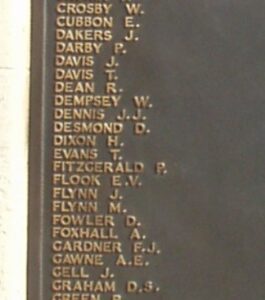
John Griffiths, Private, 5958, Royal Warwickshire Regiment. John was the son of Thomas and Mary Griffiths, of 27, Castle Street, Cardigan, and worked as a butcher in Cardigan prior to the war. He had enlisted at Cardigan into the 4th Battalion, Welsh Regiment, with the regimental number 2528, and was posted to the 2/7th Battalion, Royal Warwickshire Regiment. The battalion was attached to 182 Brigade, 61st Division, and on 21 May 1916 landed in France. The Division moved to the Fromelles area, taking over the line from the 38th (Welsh) Division, who were moving to the Somme. The Battle of the Somme had began on 1 July 1916, and the British had made no real inroads into the German defences there, so it was decided to make a feint attack at Fromelles, to attempt to keep the Germans from sending reinforcements to the Somme. On 19 July 1916 the 61st Division, and the 5th Australian Division made a suicidal assault against the strongly held German defences at Fromelles, and thousands of men were needlessly mown down. John was one of the dead that day, and was 32 years old. The regimental chaplain wrote a condolence letter to his sisters in Cardigan, stating that John had been buried and a cross erected on his grave. Sadly John is now another of the missing, and is commemorated on the Loos Memorial, France. He was thought to have possibly been one of the men buried at Fromelles in the mass grave, which was found several years ago, who had not so far been identified, but as the majority of the bodies recovered were of Australian soldiers, this is not likely.
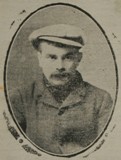
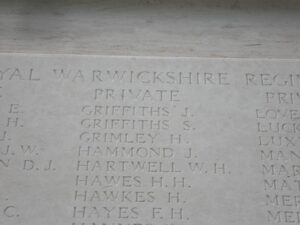
Tom Griffiths, Private, 2174, Welsh Regiment. Tom was born in 1897, the son of Daniel and Mary Ann Griffiths, of the Saddlers Arms, Cardigan. He enlisted at Cardigan into the 1/4th Battalion, Welsh Regiment, which was the local Territorial Battalion, attached to 159 Brigade, 53rd (Welsh) Division. The Division landed at Cape Helles, Gallipoli, on 9 August 1915, and was immediately thrown into action, spending the next few days in isolated pockets, fighting against a Turkish counter-attack during the Battle of Sari Bair, and then at the Attack on Scimitar Hill. Tom was killed in action here on 10 August 1915, aged 18. He has no known grave, and is commemorated on the Helles Memorial, Gallipoli.
David Jenkins, Second Engineer, Mercantile Marine. David was the son of John and Mary Jenkins (nee Rees), of Rose Vale, Northgate Terrace, Cardigan. He served with the Mercantile Marine aboard the SS Kildonan, a Cardiff registered Merchant steamer. On 29 September 1917, she was two miles off the Pendeen Lighthouse, Cornwall, when she was torpedoed and sunk by the German Submarine UB-35, with the loss of 14 lives. David was 23 years old, and is commemorated on the Tower Hill Memorial, London.
Tom Ladd, Private, 2187, Welsh Regiment. Tom was born at Cardigan in 1895, the son of William and Mary Ladd, of 3, Bath House Road, Cardigan. Tom remained in Britain for the duration of the war, after having enlisted into the London Regiment, he was discharged due to ill-health, and rejoined the 4th Welsh. Tom died at Cardigan on 13 January 1919, aged 23, and is buried at Cardigan Cemetery.
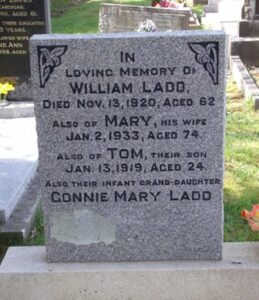
Johnnie Morgan, Private, 200499, Welsh Regiment. Johnnie was born at Cardigan, and was the Husband of Fanny Morgan, of Foundry Terrace, Cardigan. He enlisted in the town into the 1/4th Battalion, Welsh Regiment, which was the local Territorial Battalion, attached to 159 Brigade, 53rd (Welsh) Division. The Division landed at Cape Helles, Gallipoli, on 9 August 1915, and was immediately thrown into action, spending the next few days in isolated pockets, fighting against a Turkish counter-attack during the Battle of Sari Bair, and then at the Attack on Scimitar Hill. The Division remained here throughout the coming months, and suffered severe losses in manpower strength during the great November 1915 blizzard on Gallipoli, when its total strength was reduced to less than that of a full-strength Brigade. On 11 December 1915 the Division was evacuated to Mudros, and by 23 December 1915 were moved to Egypt. They remained on the Suez Canal Defences for the next twelve months, where it took part in operations against the Sultan of Darfur, and in March 1917 took part in the advance into Palestine. Johnnie was killed in action during the Third Battle of Gaza, on 3 November 1917. He was 28 years old, and is buried at Beersheba War Cemetery, Israel.
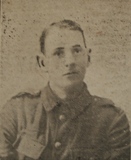
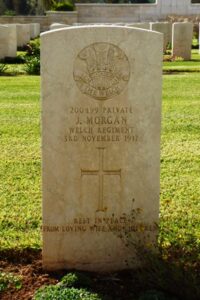
George Ivor Milton Phillips Richards, Private, 200484, Welsh Regiment. George was the son of Captain David and Annie Ida Richards, of Kelvin, Cardigan. He enlisted at Cardigan into the 1/4th Battalion, Welsh Regiment, which was the local Territorial Battalion, attached to 159 Brigade, 53rd (Welsh) Division. The Division landed at Cape Helles, Gallipoli, on 9 August 1915, and was immediately thrown into action, spending the next few days in isolated pockets, fighting against a Turkish counter-attack during the Battle of Sari Bair, and then at the Attack on Scimitar Hill. The Division remained here throughout the coming months, and suffered severe losses in manpower strength during the great November 1915 blizzard on Gallipoli, when its total strength was reduced to less than that of a full-strength Brigade. On 11 December 1915 the Division was evacuated to Mudros, and by 23 December 1915 were moved to Egypt. They remained on the Suez Canal Defences for the next twelve months, where it took part in operations against the Sultan of Darfur, and in March 1917 took part in the advance into Palestine. George was killed here at the First Battle of Gaza, on 26 March 1917, passing away in the arms of a fellow soldier. He was 23 years old, and is commemorated on the Jerusalem Memorial, Israel.
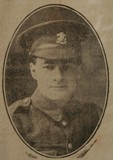
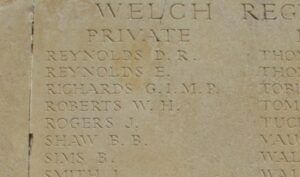
Evan James Thomas, Private, 57071, North Staffordshire Regiment. Evan was the son of Mrs. Meta James Thomas, of 21, North Road, Cardigan. He enlisted at Cardigan on 28 August 1917 into the army, and was posted to the 9th Battalion, North Staffordshire Regiment, which was in France attached to the 37th Division as the Divisional Pioneers, landing at Boulogne on 1 April 1918. Evan wasn’t long in France before he was wounded by a German gas shell on 12 May 1918. He suffered for two days, before dying at 48 Field Ambulance on 14 May 1918, aged 18. Evan is buried at Bagneux British Cemetery, Gézaincourt, France.
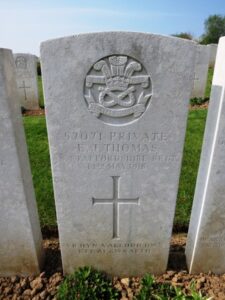
Tommy Thomas, Private, 1003, Australian Imperial Force. Tommy was born at Llanfyrnach in 1889, the son of Thomas and Mary Thomas. Thomas and Mary later moved to 1, Bridge Street, Port Talbot, while Tommy went to live at North Gate Terrace, Cardigan, where he worked as a carpenter. Tommy emigrated to Australia prior to the war, and enlisted at Queensland on 17 June 1915 into the 25th Battalion, Australian Infantry. The 25th Battalion was raised at Enoggera in Queensland in March 1915 as part of the 7th Brigade, leaving Australia in early July 1915. It trained in Egypt during August, and in September 1915 landed at Gallipoli, where it reinforced the depleted New Zealand and Australian Division. The 25th Battalion left the peninsular on 18 December 1915. After further training in Egypt, the 25th Battalion proceeded to France, landing on 19 March 1916, where it became attached to the 2nd Division. It took part in its first major battle at Pozières between 25 July and 7 August in the course of which it suffered 785 casualties. Tommy was wounded on 31 August, suffering multiple gunshot wounds, and was evacuated to the 1st Australian General Hospital at Rouen. He died of his wounds on 15 September 1916, aged 28, and is buried at St. Sever Cemetery, Rouen, France.
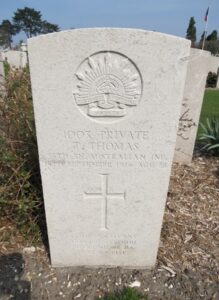
Llewellyn George Tudor, Private, 201594, Tank Corps. Llewellyn was the son of James and Hettie Tudor, of Brynderi, Cardigan. He originally enlisted at Cardigan into the 4th Welsh, and was posted to the Tank Corps. Llewellyn landed in France at some time in 1916, joining I Battalion, Tank Corps. Tanks had first been used on the Somme in 1916, with varying success. Around 60 tanks saw action at the Battle of Arras in April 1917, but proved to be a failure due to the weather. By the summer of 1917 tank numbers had increased and the better Mark IV’s were available, but they again failed at Third Ypres, due to the weather, and mud. On 20 November 1917, an attack was launched at Cambrai, and after a heavy artillery bombardment, 378 Mark IV tanks smashed through the Hindenburg Line positions. Insufficient mobile reserves could get through in time to exploit the tanks success, and within days the chance had gone, the counter-attacking Germans recaptured most of their lost positions. I Battalion was in support of the 20th (Light) Division’s attack. Llewellyn was killed at Cambrai on 23 November 1917. He was 20 years old, and is commemorated on the Cambrai Memorial, Louverval, France.
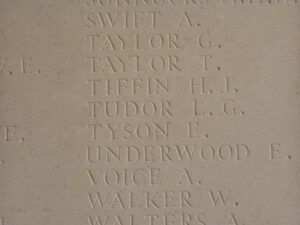
Thomas William Waters, Private, 2164, Welsh Regiment. Thomas was born at West Hartlepool in 1877, the son of James and Isabella Waters, and resided at Cardigan prior to 1897, working as a harness maker. He married Mary Ann at Cardigan in 1897, and the couple resided at Newtown, Cardigan, where they raised their son. At the outbreak of war Thomas enlisted into the 1/4th Battalion, Welsh Regiment. Thomas died within months of mobilisation, on 1 January 1915. He was 38 years old, and is buried at Cardigan Cemetery.
Lewis Wigley, First Engineer, Mercantile Marine. Lewis was born at Cardigan in 1874. He married Emily Corbetta Rees in 1909, and resided with her at Catalone, Lion Terrace, Cardigan. Lewis was a long serving engineer in the Mercantile Marine, and during the Great War served aboard the SS Brika. Brika was a defensively-armed Merchant ship. On 13 March 1917, she was 13 miles from Coningbeg Light Vessel, Ireland, when she was torpedoed without warning and sunk by a German submarine. Lewis was one of two men who died that day. He was 42 years old, and was brought home for burial at Cardigan Cemetery.
David Morgan Williams, Rifleman, 371433, London Regiment. David was the son of Owen and Catherine Williams, of 7, Queen’s Terrace, Cardigan. He enlisted at London into the army, and was posted to France with the 8th Battalion (Post Office Rifles), London Regiment, which was attached to 140 Brigade, 47th (2nd London) Division. The Division had been in France since March 1915, and David joined the battalion on 28 October 1915, at Arras. They were north of Arras when the Germans attacked Vimy Ridge, and then moved south to the Somme, where they fought at the Battle of Flers-Courcelette, and then at the Battle of Le Transloy, where the Division captured Eaucourt l’Abbe, and took part in Attacks on the Butte de Warlencourt. Early in 1917 the Division moved north to Belgium, and took part in the Battle of Messines. David was killed in action here on 10 June 1917. He was 22 years old, and is buried at White House Cemetery, St. Jan-Les-Ypres, Belgium. His brother, Owen also fell.
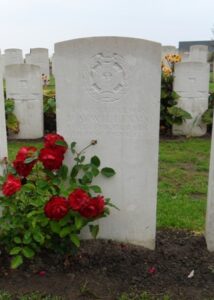
Owen John Williams, Private, 2135, Welsh Regiment. Owen was the son of Owen and Catherine Williams, of 7, Queen’s Terrace, Cardigan. He enlisted at Cardigan into the 1/4th Battalion, Welsh Regiment, which was the local Territorial Battalion, attached to 159 Brigade, 53rd (Welsh) Division. The Division landed at Cape Helles, Gallipoli, on 9 August 1915, and was immediately thrown into action, spending the next few days in isolated pockets, fighting against a Turkish counter-attack during the Battle of Sari Bair, and then at the Attack on Scimitar Hill. Owen was badly wounded during the initial fighting, and was evacuated by hospital ship to Egypt. He died at Chatby Military Hospital on 30 August 1915, aged 20, and is buried at Alexandria (Chatby) Military and War Memorial Cemetery, Egypt. His brother, David also fell.
World War Two, 1939-1945
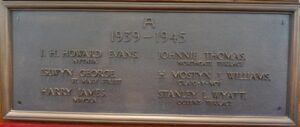
John Henry Howard Evans, Able Seaman, C/JX 168157, Royal Navy. John was the son of John Henry and Phoebe Elizabeth Evans, of Nythfa, Cardigan. He served with the Royal Navy aboard HMS Jaguar, a J class destroyer. Jaguar participated in Operation Abstention in February 1941, and engaged the Italian destroyer Crispi, and took part in the Battle of Cape Matapan. On 26 March 1942, she was struck by two torpedoes fired by the German submarine U-652, and sank off Sidi Barrani with the loss of 190 of her crew. John was 23 years old when he died that day, and is commemorated on the Chatham Naval Memorial, Kent.
John Islwyn George, Petty Officer Supply, D/MX 52755, Royal Navy. John was the son of David John and Margaret Ann George, of Maesteg, Glamorgan. He resided at St. Mary Street, Cardigan prior to the war. John served with the Royal Navy aboard HMS Charybdis, a Dido Class cruiser. On 23 October 1943, Charybdis was part of a group which had intercepted the German blockade runner Münsterland off Ushant, Brittany, when the force was attacked at night by the German 4th Torpedo Boat Flotilla. Charybdis was torpedoed by the German torpedo boats T-23 and T-27, and sank with the loss of over 460 lives off the North Coast of Brittany. John is commemorated on the Plymouth Naval Memorial, Devon.
David Henry Jenkins James, Leading Aircraftman, 1601530, Royal Air Force Volunteer Reserve. David was the son of David Phillip and Elizabeth James, of Mayola, Cardigan. He served with the Royal Air Force, and was killed in the crash of a Percival Proctor training aircraft on 26 July 1942. David was 33 years old, and is buried at Cardigan Cemetery.
Johnnie Thomas, Second Engineer Officer, Trinity House Service. Johnnie was the son of John and Elizabeth Thomas, of 7, Northgate Terrace, Cardigan. He served with the Trinity House Service aboard the lighthouse tender S.S. Argus. On 12 November 1940 Argus was in the Thames Estuary when she struck a mine and sank with the loss of all but one of her crew. Johnnie was 39 years old when he died that day and is commemorated on the Tower Hill Memorial, London.
Hugh Mostyn James Williams, Lieutenant, 222520, Royal Artillery. Hugh was from Craig-y-Nos, Cardigan. He served with 80 Light Anti Aircraft Regiment, Royal Artillery. The Regiment took part in the North African campaign, and the subsequent invasion of Italy. Hugh was killed in Italy on 8 September 1944, and is buried at Gradara War Cemetery, Italy.
Stanley Louvaine Wyatt, Seventh Engineer, Merchant Navy. Stanley was born on 5 October 1914, the son of Albert George Wyatt and Mary Lavinia Wyatt, of Queen’s Terrace, Cardigan. His father had died as a result of his service with the 4th Welsh on 27 October 1918. Stanley enlisted into the Merchant Navy in 1933 and trained as a Marine Engineer. He first served aboard the S.S. Antonio, and during WW2 was posted aboard the S.S. Hardwicke Grange. He was reported as lost at sea on 20 October 1940, aged 26, and is not commemorated by the CWGC because his death was not due to enemy action. His mother Mary had lost her brother John Ernest Williams at sea during WW1.